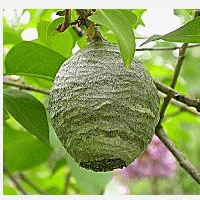Social Wasps
 Eusocial behavior among wasps is found only in certain members of the family Vespidae. These insects are commonly called paper wasps, hornets, and yellowjackets. They build communal nests by mixing wood fibers with saliva to form a paper-like material that can be molded into brood cells and other nest components. The brood comb (cells where larvae are reared) is always constructed like an inverted umbrella with open ends of the hexagonal cells facing downward. Workers usually cling to the underside of the comb as they guard the nest, feed the larvae, and perform other housekeeping chores. All social wasps are carnivores; their prey consists mostly of caterpillars and flies. The wasps chew up their victims’ bodies into a paste that can be fed to their larvae and, in return, the larvae produce a nutritional syrup that is consumed by the adults. A small colony of 200 yellowjackets may kill and eat about 5000 caterpillars over the course of a summer.
Eusocial behavior among wasps is found only in certain members of the family Vespidae. These insects are commonly called paper wasps, hornets, and yellowjackets. They build communal nests by mixing wood fibers with saliva to form a paper-like material that can be molded into brood cells and other nest components. The brood comb (cells where larvae are reared) is always constructed like an inverted umbrella with open ends of the hexagonal cells facing downward. Workers usually cling to the underside of the comb as they guard the nest, feed the larvae, and perform other housekeeping chores. All social wasps are carnivores; their prey consists mostly of caterpillars and flies. The wasps chew up their victims’ bodies into a paste that can be fed to their larvae and, in return, the larvae produce a nutritional syrup that is consumed by the adults. A small colony of 200 yellowjackets may kill and eat about 5000 caterpillars over the course of a summer.

 Types of social wasps. There are about 20 species of social wasps in North America and more than 700 species world-wide. They can be divided into three groups:
Types of social wasps. There are about 20 species of social wasps in North America and more than 700 species world-wide. They can be divided into three groups: